
Martin Luther as ‘Junker Jörg’
Portrait Group II represents the smallest group of works dealt with within the context of the KKL with only two surviving paintings[1] and three woodcuts. The depiction of Luther with a full beard and hair and a simple doublet only varies in the portrait length that ranges from a bust portrait (II.D1, II.D2) to one including the right hand with the hilt of the sword and finally to a half-length figure with both hands and a section of the sheath and blade of the sword (II.M2, II.D3).
[1] Only versions of the subject from about 1537 combine the portrait of ‘Junker Jörg’ with the depiction of Katharina of Bora, see for example the double portraits in the Muskegon Museum of Art [US_MMA_39-5](https://lucascranach.org/US_MMA_39-5) and [US_MMA_39-6](https://lucascranach.org/US_MMA_39-6).
Historical Context and Dating of the Paintings

Abb. 1: Lucas Cranach d. Ä., Martin Luther als "Junker Jörg", um 1522, Malerei auf Buchenholz, Museum der Bildenden Künste, Leipzig, KKL-Nr. II.M1

Abb. 2: Lucas Cranach d. Ä., Martin Luther als "Junker Jörg", um 1522, Malerei auf Buchenholz, Klassik Stiftung Weimar, KKL-Nr. II.M2
Neither of the paintings (fig. 1 and 2) is dated, but scholars generally place them between 1521 and 1522, inspired by a report made by Matthias Ratzeberger after 1559 and not published until 1850. According to this Cranach painted a portrait of Luther as ‘Junker Jorg’[1] during Luther’s brief return to Wittenberg from the Wartburg between the 3/4 and 12 December 1521. Recently Thomas Kaufmann rejected this traditional interpretation arguing instead for a later date around 1537 for their completion.[2]
The traditional dating in the early 1520s can now be affirmed by means of recent technical examinations and critical evaluation of primary sources. [3] The youngest dateable growth ring on the Leipzig beech panel is from the year 1519.[4] Provided that the entire cross-section of the trunk was used and only the bark was removed, the painting could have been created in 1521, after the wood had been seasoned for two years.[5]
Vogt Sebastian Langhans of Magdeburg also writes to his employer Albrecht of Brandenburg about a painted portrait of ‘Junker Jörg’ in a letter from 26 April 1523. Shortly before the 16 February 1523[6] Langhans confiscated ‘a panel with a picture of Lucretia painted on the outside and on the inside a bust of Martin Luther of Wittenberg. Portrait with the sword and beard in a black jacket’.[7] from the Magdeburg bookseller Nickel Apfelstadt[8]. The words ‘außerhalben’ (outer) and ‘inwendig’ (inner) do not describe the recto and verso of a single work[9], but rather the outer and inner sides of a self-contained unit.[10] This might have been a case, as they were widely used at the time to protect portraits, and if so the exterior was possibly a painted sliding lid.[11] However, it could also have been a portrait in a frame that was covered with a sliding panel.[12] Both variants would offer a convincing explanation why Langhans explicitly referred to a ‘panel with a picture of Lucretia’. Accordingly, the ‘Lucretia’ would have been depicted on the exterior, on the moveable cover of a Luther portrait so that it could be kept safe in the Roman Catholic Archdiocese of Magdeburg without it being visible to everyone. Only a painted depiction of Luther as ‘Junker Jorg’ would seem likely for the particular constellation of these two subjects. The description, mentioning the sword, beard and black doublet corresponds with both portraits by Cranach in Leipzig and Weimar, however the painting may not necessarily be either of these.[13]
A largely overlooked note from 1522 proves that even at this early stage portraits of Luther were commissioned and painted. On the 15 October 1522 Philipp Glüenspiess[14], who was resident in Wittenberg, wrote to his cousin Georg Römer, a lawyer from Nuremberg, that Lucas Cranach the Elder sends his best regards and will paint a portrait of Luther with great care and much diligence.[15] However, as the completion was delayed, Glüenspiess reported with annoyance on the 2 November that he would ensure a quick delivery.[16] With that a client for a Luther portrait is named for the first time.[17] Considering that there is no information to suggest the existence of another type of painted Luther portrait in the early 1520s and that at least one painting from 1523 of ‘Junker Jörg’ is documented, it would seem likely that Römer’s commission also referred to a depiction of Luther as ‘Junker Jörg’.[18] The delay in the delivery also confirms what up until now has only been suggested by the few surviving portraits on panel of Luther as ‘Junker Jörg’: that in the early 1520s portraits of Luther on panel were painted in the Cranach workshop as they were commissioned and not mass produced in advance as was the case from 1525 with the paintings from Portrait Group III.
[1] For the evolution and modification of the ahistorical term ‘Junker Jörg’ see Schwarz 2012, pp. 209-213.
[2] See Kaufmann 2019 and id. 2020, pp. 36–47.
[3] See the catalogue entry for II.M1.
[4] Peter Klein, report on the dendrochronological examination of the panel painting ‘Martin Luther als Junker Jörg’, Museum der Bildenden Künste Leipzig, Inv. no. 946, 30.11.2020, [DE_MdbKL_946](https://lucascranach.org/DE_MdbKL_946). By comparing all the dendrochronological results of beech panels from the Cranach workshop provided by Peter Klein it was established that the average storage period was four to five years. On the basis of this and irrespective of other factors the portraits in Leipzig could have been produced in the early 1520s.
[5] ibid.
[6] According to Staatsarchiv Sachsen-Anhalt, Standort Magdeburg, A2, 617, fol. 23r, Langhans describes to Albrecht of Brandenburg the moment when he confiscated the work, ‘in the absence of your electoral grace, shortly before your electoral grace returned home’ („Inn e[uer] Churfürstlichen gnaden Abweße' kurz vor e[uer] Churf[ürstlichen] g[naden] wyder anheimisch Kommen“). According to Albrecht’s itinerary he was at the Diet of Nuremberg until the 9 February 1523, but was already back in Halle by the 16 February 1523. He remained there until September. Langhans can therefore only mean the period before his return from Nuremberg. For the itinerary see Scholz 1998, pp. 364–365.
[7] The State Archive Saxony-Anhalt, location Magdeburg, A2, 617, fol. 23 recto. A brief mention of this episode can be found in Hoffmann 1847, p. 34 and Hülße 1880, p. 172, somewhat more detailed in 1883, p. 23. Schade incidentally mentions this event, with the wrong date of 1521, and without citing a source. See Exhib. Cat. Hamburg 2003, no. 79, p. 182. The passage is not only revealing because it records the unusual pairing of a representation of the classical heroine Lucretia with a depiction of Luther as ‘Junker Jörg’, but also because on closer reflection it would seem very apt to combine the depiction of a Roman virtuous heroine, whose death led to the overthrow of the Tarquin kings in Rome, with Luther as ‘Junker Jörg’, who at the time may still have been presumed dead.
[8] Little is known about Nickel Apfelstedt. His participation in the fair at Leipzig is documented for about 1515, 1519, 1522 and around 1525 (see Kirchhoff 1885, p. 25 as well as Grimm 1967, col. 1590), in 1519 he was also at the fair in Naumburg (see Kirchhoff 1885, p. 26). On the 25 April 1522 he is mentioned in a publishing contract for a Lutheran pamphlet of songs (see ibid. p. 38; Wittkowski 1909, p. 55, Quellenedition bei Gess 1985, p. 312–313, no. 336).
[9] Schade wrongly assumes this in Exhib. Cat. Hamburg 2003, no. 79, p. 182.
[10] Two examples with this meaning have been singled out from the numerous contemporary ones. In 1535 Cranach received payment from the electoral court for ‘painting the whole house inside and outside and the cloths’ („das ganz hauß außwendig und inwendig und die tucher anzustreichen“) as well as in 1543/1545 for ‘painting work to paint the interior of the church […] and to rework and paint the exterior’ („tuncher arbeit vonn der kirchen inwendig zutunchenn […] vonn der kirchenn auswendig zuberappen unnd tunchenn“). Citation after Heydenreich 2007, pp. 429 and 439.
[11] See Dülberg 1990, pp. 41–43.
[12] The most well-known example employing this solution is a portrait of Hieronymus Holzschuher by Dürer in Berlin, which bears the sitter’s arms of alliance on the cover.
[13] Unlike the portrait in Leipzig the original frame for the example in Weimar has not survived. Recent technical examinations revealed that the panel in Leipzig had been cropped along the bottom edge and only then was it fitted in the present frame. The painted hilt of the sword is covered by the bottom member of the frame. Although now the sword is only suggested by its pommel in the original format it may have been more visible.
[14] For this see Scheible 2005, pp. 155–156.
[15] See Feuerlein 1718 [VD18 90740262], p. 147: „Effigiem Lutheri cum summo studio acrique diligentia tibi conficiet Lucas Kranach, qui te amanter salutat.“ The letter belongs to the estate of Ernst Salomon Cyrians held in the Forschungsbibliothek Gotha (Chart. A 395, sheet 4r/v). A slightly different printed version in Anonymous 1906, p. 412. See also Meurer 2020, pp. 108–114, here p. 112. We are grateful to Susanne Meurer for drawing our attention to Grüenspiess’ letter.
[16] See Feuerlein 1718 [VD18 90740262], p. 150:„Effigies Doctoris M. nondum fuit confecta: Dii malefaciant indiligentiae pictoris, spero tamen brevi missurum tibi. Dabo igitur operam, ut illico conficiat eam pictor.“ See this letter in the Forschungsbibliothek Gotha, Chart. A 395, sheet 5r/v. Also see Anonymous 1906, p. 413. Regarding the letters see also Borcherdt 1925, p. 504, who interprets the reference as evidence for a planned drawing. The fact that Glüenspiess refers to the great care taken by the painter and that the completion took a long time appears to imply a panel painting, as correctly assumed by Meurer 2020, p. 112.
[17] Römer belonged to a patrician family from Nuremberg that had gained its wealth from the Mansfeld mining industry. Born in Mansfeld, Römer studied in Leipzig and from 1518/1519 in Wittenberg; his uncle Hans Reinicke was one of Luther’s childhood friends. In 1530 Römer visited Luther with his uncle while the former was in the Veste Coburg during the Diet of Augsburg. See Brecht 1986, p. 363. Römer’s art collection had already received much praise from his contemporaries, and included works by Titian and Dürer. See Meurer 2020, p. 112.
[18] Nevertheless, it should be noted that portraits of Luther like I.6.M1 to I.6M3 could also have been produced at this time.

Abb. 3a: Auflage A, Exemplar der Staatlichen Kunstsammlungen Dresden, Detail Super- und Subscriptio

Abb. 3b: Auflage B, Exemplar der Staatsbibliothek zu Berlin - Preußischer Kulturbesitz, Detail Super- und Subscriptio

Abb. 3c: Auflage C, Exemplar des Germanischen Nationalmuseums Nürnberg, Detail Super- und Subscriptio

Abb. 3d: Auflage D, Exemplar der Staatlichen Museen zu Berlin - Preußischer Kulturbesitz, Kupferstichkabinett, Detail Super- und Subscriptio

Abb. 3e: Auflage E, Exemplar des Herzog-Anton-Ulrich-Museums Braunschweig, Detail Super- und Subscriptio

Abb. 3f: Auflage F, Exemplar des Herzog-Anton-Ulrich-Museums Braunschweig, Detail Super- und Subscriptio
Historical Context and Dating of the Woodcuts
A similar early dating is implied by Cranach’s corresponding woodcuts examined within the context of the KKL. At least six editions of the woodcuts are recorded. These differ in the accompanying super- and subscriptiones as well as in the breaks in the lines, allowing them to be arranged in a relative order (fig. 3a-f). They could be compared for the first time thanks to technical examinations carried out on the originals for the KKL (Editions A-F).[1]
[1] The chronological and typological sequence undertaken to date by Mennecke 2012 and Schwarz 2012 can be complemented with further impressions.
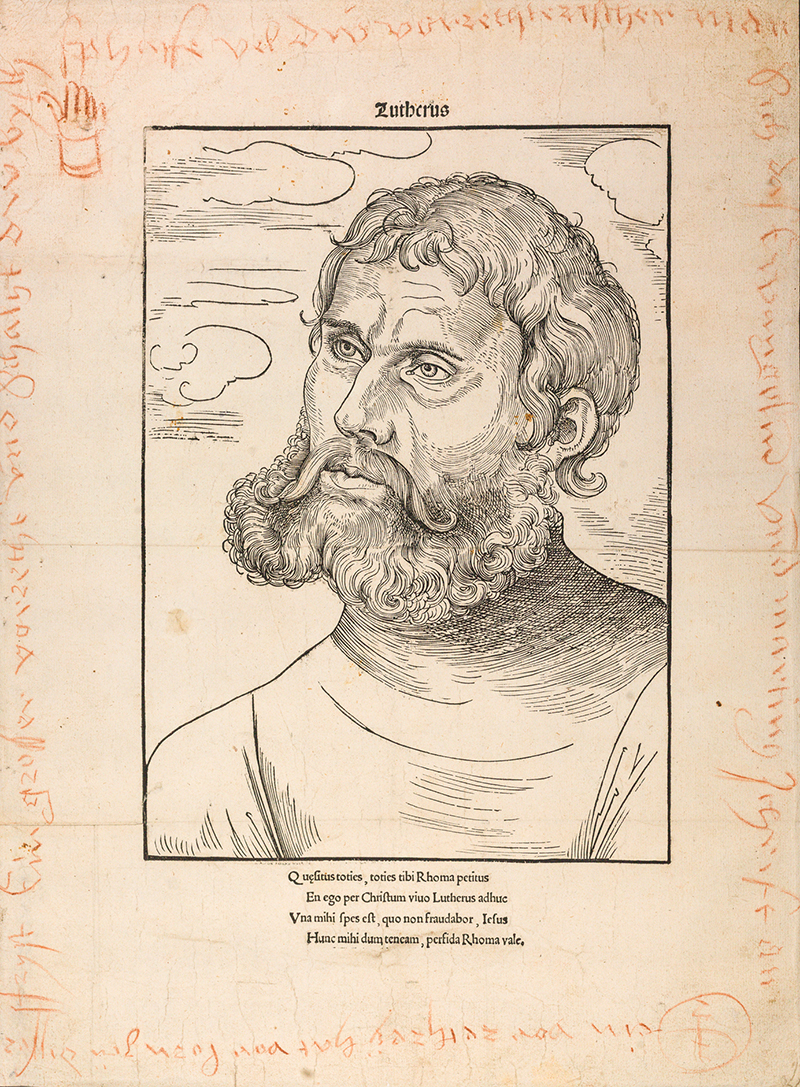
Abb. 4: Lucas Cranach d. Ä., Martin Luther als „Junker Jörg“, Brustbild, nach links gewandt, vor Wolken, vor 1. April 1522, Holzschnitt mit Typendruck, Exemplar der Staatlichen Kunstsammlungen Dresden, KKL-Nr. II.D1
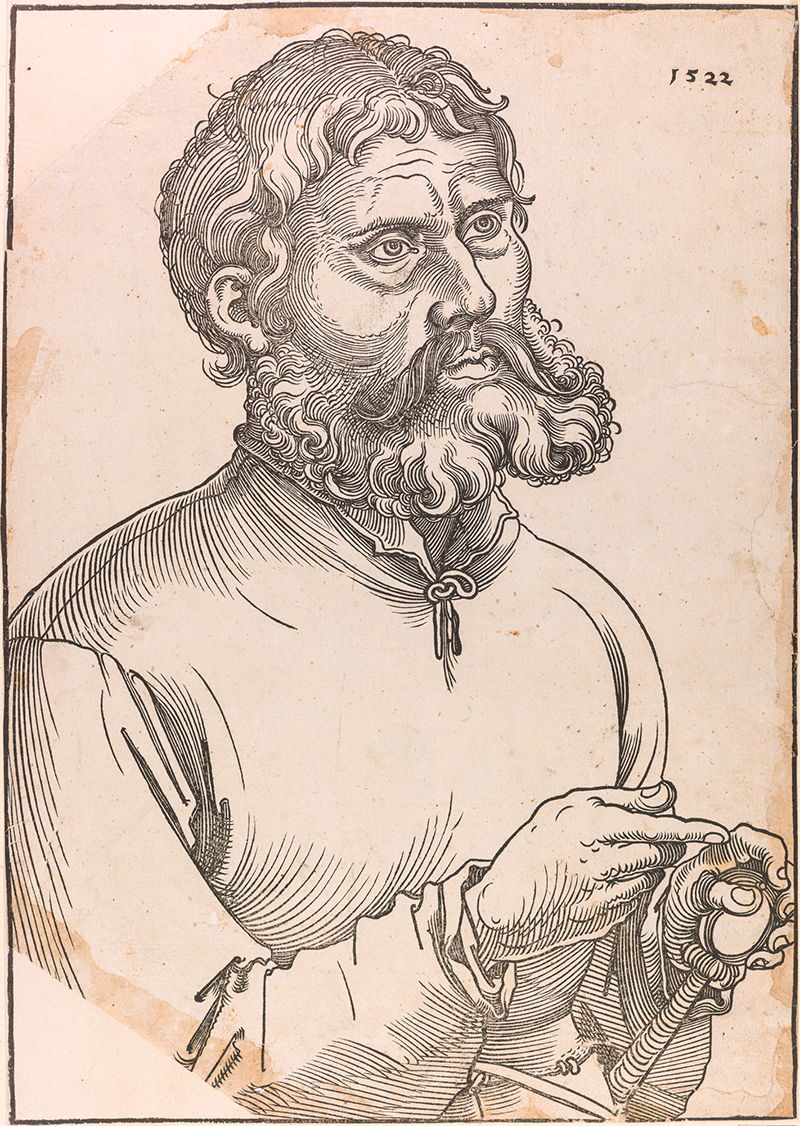
Abb. 5: Hans Sebald Beham (?), Martin Luther als „Junker Jörg“, Halbfigur, nach rechts gewandt, mit Schwert, 1522, Holzschnitt, Exemplar der Staatlichen Museen zu Berlin - Preußischer Kulturbesitz, Kupferstichkabinett, KKL-Nr. II.D3
The date of these editions spans a period from before the 1 April 1522 (Edition A) to after 1579 (Edition F). Only editions A and B (in four examples known today) were published during Luther’s lifetime, whereas the majority of the surviving sheets were probably published after Luther’s death in 1546.[1]
Primary sources document the first appearance of edition A in Spring,1522. In a letter dated between the 16 and 19 April 1522 the altarist Lucas Lederer from Oschatz asks Johann VII of Schleinitz, Bishop of Meissen, for protection against slander of his person and vandalism to his home.[2] Lederer describes the persecution by an individual on the 1 April 1522, who broke the windows of his house. The suspect was carrying ‘a letter’ with an anticlerical satirical verse, that Lederer quotes verbatim.[3] According to Vogt Bartholomäus Gortler who was entrusted with the investigation the accused, a scribe called Erhard of Hertzerkg[4], claimed that he had found the confiscated ‘letter with a printed picture around which there were many rhymes written in red chalk’[5]. The ‘scribe had picked this up and wanted to read it and stood still, but in the darkness of the night he could not decipher the handwriting and put the letter under his gown’[6] It remains unclear whether the accused and the author of the verse are one and the same person.[7]
This episode can be associated with an impression of the woodcut in the Prints and Drawings Cabinet in Dresden (fig. 4), which shows Luther’s portrait with an inscription in red chalk running around it that on the whole appears to correspond with the text cited by Lederer.[8] Moreover, on the reverse the sheet exhibits one vertical and three horizontal folds with dirty edges, indicating that the sheet was cross-folded to an eighth of its actual size and therefore would have fitted into a coat pocket.[9] Accordingly it is conceivable that the sheet in Dresden, which also exhibits a watermark[10] that was in circulation by 1522, is the very one referred to by Gortler as the ‘letter with a printed picture […], around which there were many rhymes written in red chalk’ and as such can be dated to just before the 1. April 1522.[11]
A date of 1522 for the ‘Junker-Jörg’ woodcut is also suggested by an external reference to the subscriptio on edition A. The quatrain ‘Quęsitus toties, toties tibi Rhoma petitus || En ego per Christum viuo Lutherus adhuc || Vna mihi spes est, quo non fraudabor, Iesus || Hunc mihi dum teneam, perfida Rhoma vale’ is worded in exactly the same way in Wolfgang Reichart‘s (1486-1546/7) handwritten Epistolarium.[12] The municipal doctor from Ulm is one of the earliest[13] supporters of the reformation movement and was in regular correspondence with Martin Luther and Philipp Melanchthon through his friend Johannes Magenbuch (1500–1555)[14], who began his studies in Wittenberg in April 1518. The context within the epistolarium indicates that the poem entitled ‘Lutherus de se ipso’ is from 1521-1523[15], because it appears between two poems on the death of Pope Leo X (1 Dec. 1521)[16] and two other poems about portraits of Luther (De imagine Lutheri and Aliud) from 1523. Even Luther himself felt that his survival stood in stark contrast to the sudden death of Pope Leo X.[17]
Since for stylistic reasons Reichart cannot be the author [18] and moreover it is hard to explain why a poem by him would be printed in Wittenberg in the form of a personal statement by Luther, it can be assumed that he took the text from pamphlets.[19] Such an impression could have been available to Reichart[20] at the earliest after September 1522[21], probably before May 1523 and definitely before 1535.[22]
In addition, Cranach’s woodcut was taken up by Hans Sebald Beham (fig. 5) and in its first state (II.D3.1) has a xylographic inscription with the date 1522, which corresponds with the suggested first appearance of Cranach’s woodcut. Beham’s design is a mirror image of the prototype, and Beham has increased it to a half-length figure that corresponds with the composition in the Weimar painting. However, he did choose a different position for the hands and the sword. The woodcut picks up the main compositional lines in the face such as the cheeks, the forehead the contours of the nose as well as the distance between the eyes, however it does not take over the exact form of the other elements. The second state of Beham’s printing block, that has been considerable cropped on three sides, possibly due to damage, was deployed in at least two further printing campaigns (II.D3.2), which on the basis of the watermarks found on the impressions can be dated to the second half of the 16th century and the first half of the 17thcentury.[23]
It follows that depictions of Luther as ‘Junker Jörg’ were already in circulation in printed form before 1 April 1522 and in painted form possibly as early as November 1522 and definitely by February 1523.
Observation on the creative process
Although the layer structure and execution of the paintings in Leipzig (II.M1) and Weimar (II.M2) differ,[24] their underdrawings are very similar: both are executed with a brush in a blackish, fluid medium using very few lines and they correspond in shape as well as absolute size (fig. 6). The underdrawings of both paintings exhibit two different types of line. In addition to the quite rapidly applied freehand brushstrokes found particularly in the hair and fingers there are thinner, somewhat shaky lines employed for the facial features. These may have been produced by going over an initial design that is not visible in the infrared reflectogram.[25] The underdrawing also corresponds almost exactly with the shape and size of Lucas Cranach’s woodcut (fig. 7 and 8). A fine, light line can be detected at the centre of the printed line on all of the impressions from the woodcut that were examined. It can be interpreted as a mark from a scribe that was used to transfer the design to the block. Therefore, it seems reasonable to conclude that the two paintings and the woodcut relied on the same prototype to render Luther’s most characteristic features as recognizable as possible both in printed and painted media. The woodcut was not required to produce the painting nor was the painting necessary to produce the woodcut.
[1] For the quantity and dating of these editions see the classification text for II.D1.
[2] For a general understanding of this dispute see Wartenberg 1988, p. 38ff.
[3] ‘Priest, you traitorous man, || how did you begin your traitorousness || your traitorousness is to no avail up to now || therefore you are a traitor and a scoundrel.’ („Pfaff, du vorreterischer man, || wie hastu dein vorreterey gefangen an || Dein vorreterey ist umbsunst zu dieser frist, || dorumb du eyn vorreter und eyn schalk bist.“) For the whole letter see: Gess 1905, no. 331, pp. 304–306, citation p. 305, lines 21–24.
[4] His name first emerged in connection with the investigation of the circumstances initiated by Duke Georg, see Gess 1905, no. 340, p. 322, line 27.
[5] „brif mit eynem gedruckten pilde funden, dorumb seind etliche reyme mit rotelstein geschrieben gewest“, cited after Gess 1905, no. 334, p. 308, line 35.
[6] „der schreyber ufgehoben und lesen wollen und stille gestanden, aber er hat bey nacht dy schrift nicht erkennen konnen und hat den brif under den rock geslagen.“, ibid., p. 308, line 37– p. 309, line 2.
[7] According to information from Ulrich Bubenheimer, e-mail 13.08.2019, based on the writing style the scribe was probably from southern Germany.
[8] A transcription by Ulrich Bubenheimer based on high resolution digital images reads as follows: „Phafe vel dw vorrethterischer man || Sich das Ewangelium vnnd martinus schrift an || Dein vorrethrey hat vorlorn zcu disser || Fryst Ein grosser vorrether vnnd Schalgk dw bysth“. The slight difference in the wording of the description could be due to the fact that Lederer does not convey the described events by letter until more than two weeks later. Moreover, Gortler has already pointed out inaccuracies in Lederer’s description.
[9] The outer edges of these folds still exhibit greater soiling than the inner ones.
[10] Watermark, a Catharine wheel with a single contoured middle circle, six spokes and six knives attached to the rim, above it a plant with five branches each bearing a trefoil (‘Katharinenrad mit einkonturigem Mittelkreis, sechs Speichen und sechs außen aufgesetzten Messern, darüber Pflanze mit fünf Zweigen, daran je ein Dreiblatt’), dimensions: 78 x 32 mm, see [Briquet] no. 13375, Belegort Nemours (FR), 1494. Further watermarks with a similar motif are recorded from 1478 to 1539, see [WZIS].
[11] Kaufmann justifies his doubt about whether the sheet in Dresden is the same as the one mentioned by Gortler with the hypothesis that, because his lords were hostile towards Luther, Vogt from Oschatz would not have omitted to mention the Reformer’s name in his letter if the sheet had had the header ‘Lutherus’. Gortler‘s report challenges this assumption as it indicates that Vogt never in fact saw the sheet himself, and only reported the results of the cross-examination of the scribe to Duke Georg. It is understandable that the accused scribe chose the most harmless wording. In further investigations by Georg of Saxony he even claimed to have forgotten the content of the sheet, without doubt a similar protective assertion.
[12] Printed with minor modifications in Schellhorn 1725, pp. 290- 311 and 497-512, ibid. 511-512 [VD 18 90280288].
[13] This information is provided by a letter to Christoph Hegendorf on 28 January 1521. See Schellhorn 1725, p. 508.
[14] See Assion 1972, pp. 353-421, here p. 363ff.
[15] The poem is positioned between letters and documents from 1521 (see fol. 250r and 251v), to be precise after an ironic epicedion on Eck (on the occasion of the Leipzig Disputation, written no earlier than August/September 1520 (as mention of the papal bull in the last two lines suggests) but before a letter to Luther dated 3 May 1523 (fol. 247r and 257r-257v = WABr 3,33, lines 12- 36).
[16] In his edition Schellhorn only used the first quatrain. Schellhorn 1725, p. 512.
[17] See his letter to Albrecht of Brandenburg in: WABr 2, p. 408, line 59.
[18] Information received from Walther Ludwig, 09.08.2019 in an email.
[19] Contrary to Preuß 1913, p. 65. Preuß ascribes the poem to Rychardt, who according to a letter to Johannes Magenbuch on the 3.9.1522 (Schellhorn 1725, pp. 304-307 [in Ms. fol. 274r]) had composed several distiches while Luther was in Worms. Whereas Reichart repeatedly emphasized his authorship regarding these distiches this is not the case for the ‘Imago Lutheri de se ipso’.
[20] See Ludwig 1999, pp. 132-137.
[21] In September 1522 Reichart asked Magenbuch to greet Luther and Melanchthon from him, whom he had never met but knew from their writing. See Schellhorn 1725, p. 307.
[22] Ludwig 2004, pp. 199-230, here pp. 204, 220 et passim.
[23] See catalogue entry for II.D3.
[24] See the technical examination report of II.M1 [DE_MdbKL_946](https://lucascranach.org/DE_MdbKL_946)
[25] There is no distinct evidence for the use of a transfer method.
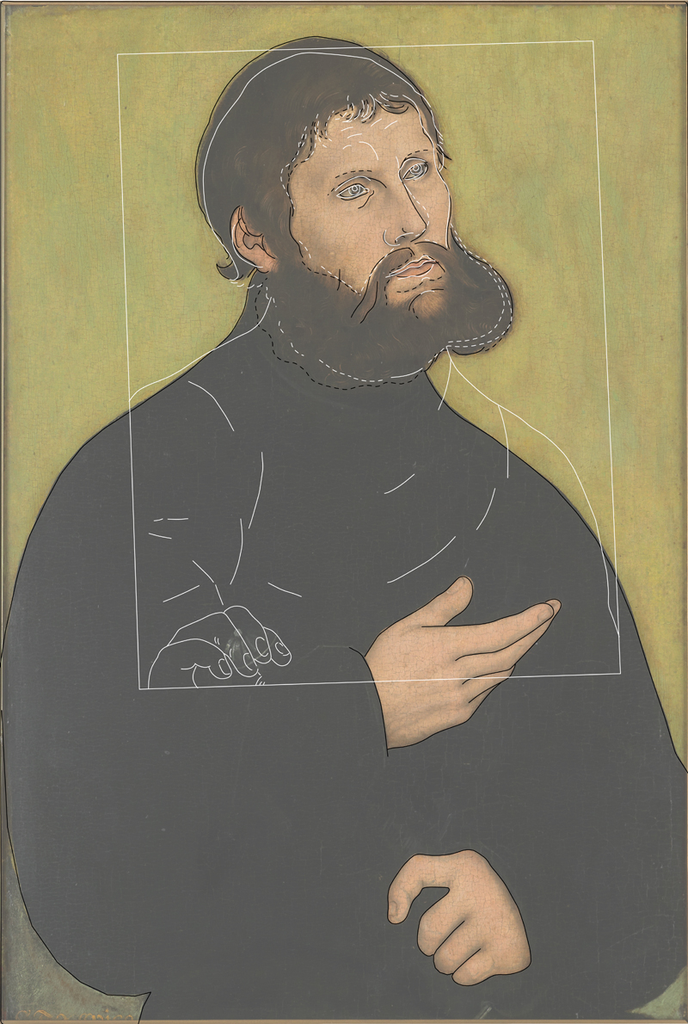
Abb. 6: Überblendung des Weimarer Gemäldes (II.M2) mit der Umzeichnung desselben in Schwarz sowie der des Leipziger Gemäldes (II.M1) in Weiß
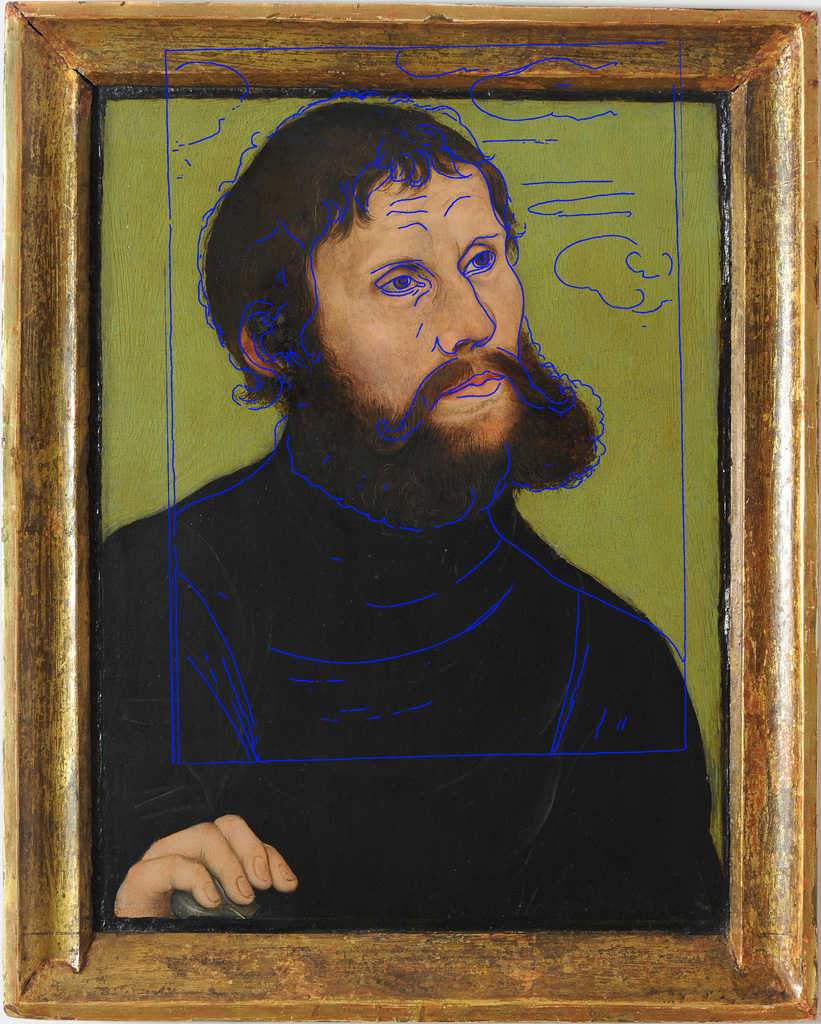
Abb. 7: Überblendung des Leipziger Gemäldes (II.M1) mit der Umzeichnung des Dresdner Holzschnitt-Exemplars (II.D1) in Blau
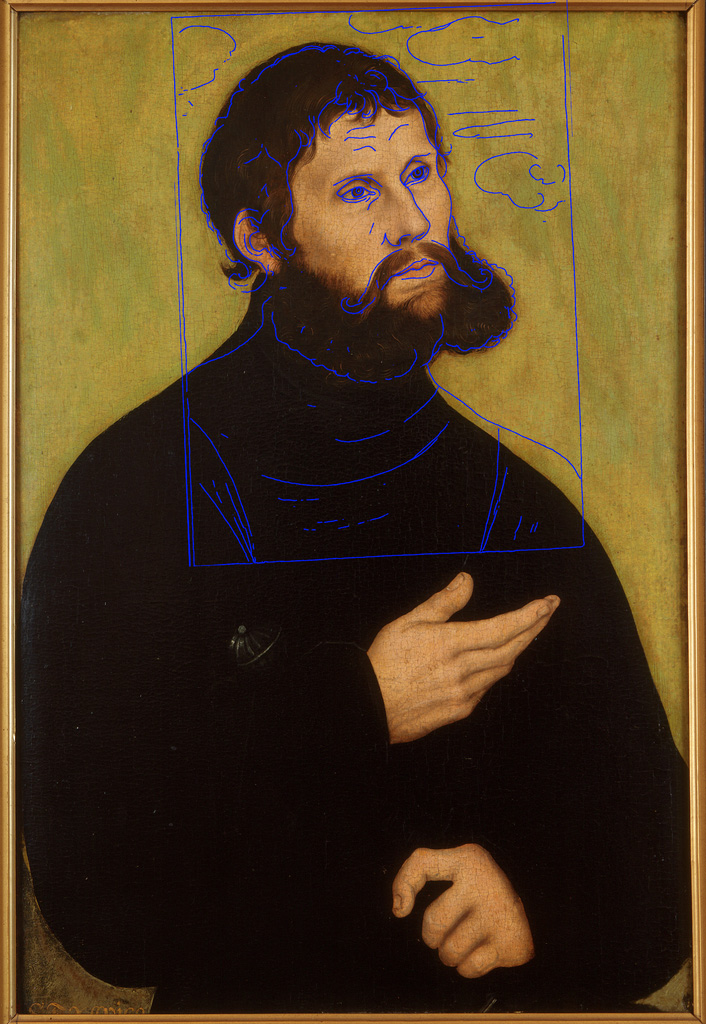
Abb. 8: Überblendung des Weimarer Gemäldes (II.M2) mit der Umzeichnung des Dresdner Holzschnitt-Exemplars (II.D1) in Blau
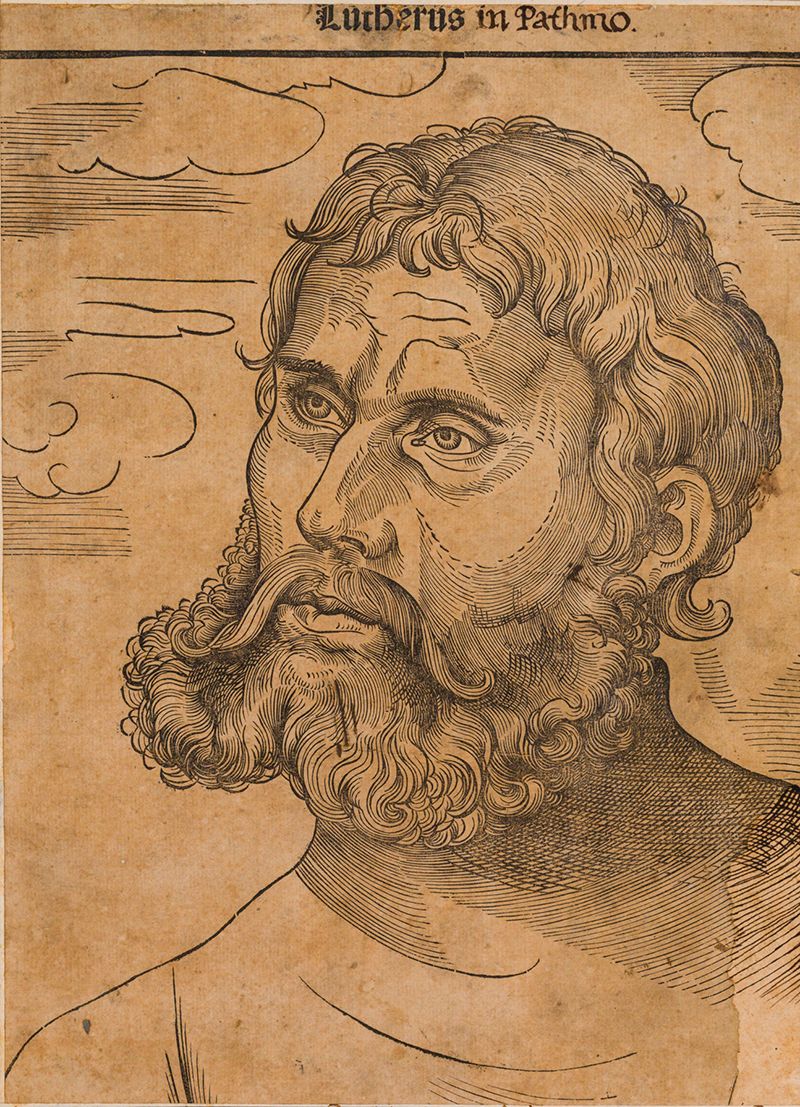
Abb. 9: Kopie nach Lucas Cranach d. Ä., Martin Luther als „Junker Jörg“, Brustbild, nach links gewandt, vor Wolken, um 1522 (?), Holzschnitt mit Typendruck, Exemplar des British Museum London, KKL-Nr. II.D2
In contrast the woodcut itself was used as a template for the other two printed works in Group II (II.D2 as well as II.D3). When the first edition was published it was recut in the same format and faithfully replicated down to the last detail by an unknown artist (II.D2). [1] A unique impression of this version survives in the British Museum in London (fig. 9) and like Edition A (however with a different typeface) bears the typographic name ‚Lutherus‘ above the sitter. It would be almost impossible to produce this woodcut without transferring the prototype directly. Given the circumstances it is remarkable that Lucas Cranach’s original is not mirrored horizontally in the woodcut.[2] Evidently here additional care was taken to transfer the lines from the original to the new woodblock both in accurate detail and the right way round.
Reason for the creation of the image
After Luther left the Diet of Worms on the 26 April 1521 and was taken to safety in the Wartburg by supposed adversaries in a simulated abduction on the 4 May confusion about his fate continued to prevail in the Empire. News about the ambush on Luther spread within a very short time. As early as seven days later the news had reached Worms, 13 days later Dürer, who was in Antwerp at the time, had also been informed.[3] In his frequently cited diary entry he expressed doubts as to whether Luther had survived[4], and during the course of writing came to the obvious conclusion that Luther was dead.[5] This fear was also raised by the author of ‘Acta et res gestae’, a pro-lutheran description of events at the Diet of Worms, which may have been published immediately after, when in the last section after the description of Luther’s departure from Worms he asks God to bestow on him a long life.[6]
Of course it did not remain a secret that Luther had survived: by the 16 May the state council of Castile was informed about it,[7] and by June numerous letters and documents written by him left the Wartburg; although initially confidential, many of these had also been published no later than July.[8] Accordingly, a new portrait of the Reformer would serve not only to make clear to the general public within the empire that Luther had survived, but above all his continued readiness to oppose the Roman Catholic Church.
Exactly that is communicated by the printed Latin quatrain beneath the portrait of the first edition, which can be translated as: ‘Though so often sought and persecuted by Rome, I, Luther, still live thanks to Jesus Christ. I have only one hope, which will not disappoint me: Jesus. As long as I trust in Him, farewell perfidious Rome!’[9] In this spirit Luther wrote to Cardinal Albrecht of Brandenburg from the Wartburg on the 1 December 1521: ‘Your Electoral Grace just do not think that Luther is dead. He will freely and merrily insist on the God who humbled the Pope’.[10] The background of the woodcut is of significance in this context particularly as this is the only portrait by Cranach that shows the sitter in the open air.
The striking association of Luther with a knightly figure in a portrait is already documented at the beginning of 1521. As was explained in the text about Portrait Group I a large format pamphlet combining the portraits of Luther and Ulrich of Hutten is documented in Worms on the 8 February 1521.[11] Hutten[12], whose right hand rests on the hilt of a sword, appears here in armour together with Luther as a monk on a pamphlet that is dedicated to them as, ‘the champions of Christian freedom’.[13] Hutten’s ‘Gesprächbüchlein’, which was published after the 1 May 1521 by Schott in Strasbourg takes this up in an illustration by Hans Baldung Grien on the title page,[14] in which the monk and knight are also united as full-length figures. That this is intended to carry the message of Luther and Hutten as comrades in arms against Rome is shown by a symbolic satire from Sélestat in Alsace, published on 17 March 1521, in which Papists attached printed portraits of Luther and Hutten together to the posts of the municipal gallows.[15] Unlike Cranach’s woodcut the surviving paintings as well as the woodcut by Beham show Luther in his disguise complete with sword. The attributes in these depictions of Luther explicitly refer to the earlier idea of the champion of Christian Freedom[16] or rather focus it now solely on the figure of Luther. In addition a further idea is also embraced in the figure of ‘Junker Jörg’, one which Erasmus with his ‘Enchiridion militis christiani’ had already introduced into the canon of humanism in 1503, a text that was translated into German only a year before the first appearance of the ‘Junker Jörg’ representations.[17]
The extent to which ‘Junker Jörg’ was accepted as a form of visual journalism can only be roughly reconstructed. Two book illustrations from anti-Lutheran texts[18] present Luther as a provocateur in armour with sword and tonsure, without it being possible to say with certainty whether this is a direct reference.
[1] British Museum London, Inv. no. 1870,0625,561.
[2] On this phenomenon see Schuchardt 2004, esp. pp. 16–17.
[3]
[4]
[5]
[6]
[7]
[8]
[9]
[10]
[11] Aleander describes the pamphlet there, see Kalkoff 1897, pp. 79–80.
[12] For the relationship between Luther and Hutten see Schilling 1988.
[13] For further examples of similar pamphlets with Luther and Hutten and the German verse see the classification texts for I.2D7 and I.3D2 as well as Schilling 1988, pp. 103–109
[14] It cannot be excluded that the original pamphlet „CHRISTIANAE LIBERTATIS PROPVGNATORIBVS“ was also printed by Schott and was possibly published under Hutten’s initiative or at least with his knowledge. See the classification of I.3D2.
[15] This is reported to Hutten by the council of the town of Sélestat in a letter from the 27 March 1521: ‘On Sunday Inuocauit (the fifth in Lent) […] both of your [Hutten and Luther] falsified bust portraits were found attached to our gallow posts’, („[…] vff Suntag Inuocauit […] euer beider [Huttens und Luthers] getrugt brustbildung geschriben an vnsres galgens seulen einer angekleipt funden worden […]“). Cited after Knod 1894, p. 125. According to the letter by Johannes Sandizeller from Sélestat to Beatus Rhenanus, in which the same circumstances are described an additional German satire about Luther and Hutten is mentioned: „[…] apud nos Schletstadii figura s. Lutheri et Hutteni in chartula depicta cruci seu (malunt ut aliqui) patibulo affixa est, cum hisce subscriptis maternae linguae rithmis […]“. Cited after Horawitz/Hartfelder 1886, no. 421, p. 563. See also Knod 1894, p. 124.
[16] Within this context it is probably not by chance that in his book ‘Sabbata’ Kessler describes a firsthand encounter with Luther disguised as a junker, who he mistook for Ulrich of Hutten. See the edition of ‘Sabbata’, by Egli/Schoch 1902, p. 79.
[17] Translation by Johannes Adelphus, Enchiridion oder handbũchlin eins Christenliche(n) vnd Ritterlichen lebens, Basel 1520, VD16 E 2787. VD16 M 7088 and VD16 E 1102. See also Mudrac 2012, pp. 158ff.
[18]